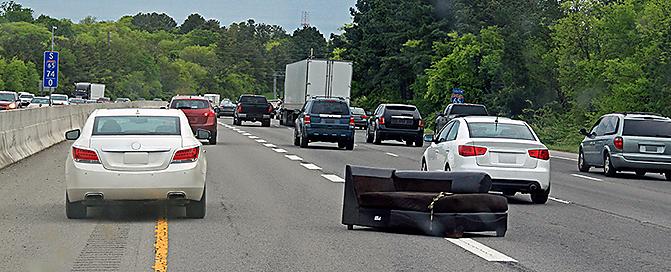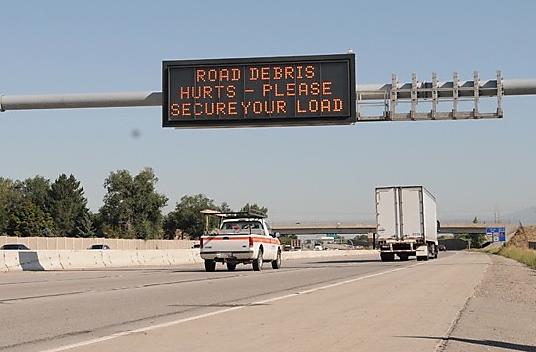What is a Working Load Limit?
Published on 01/11/18
Updated on 07/31/2024

What is a Working Load Limit?
A common question we get is, “What is the working load limit”? or “What does working load limit mean”? Well, we are here to help. A working load limit is the maximum load capacity that is given for tie down straps.
So, what exactly is a Working Load Limit and what does it mean? A Working Load Limit also known as a (WLL) is the active amount of stress that ratchet straps and tie-down straps can withstand before ultimately failing. You can find where the working load limit rating for a tie down strap is rated for traditionally stitched into the tie down webbing of the cargo straps.
The Working Load Limit is factored in by using one-third of the straps breaking strength. For example, a 10,000-pound breaking strength of force before failure would result in a 3,333-lb working load limit. This allows for extra fail-safes to be put in place to keep you and your load safe.

An example of what a Working Load Limit tag will look like is pictured above. In the demonstration, you can find the safe working load limit rating in both lbs and kgs quickly and easily. In this case, the working load limit tag is good for 915 lbs. or 416 kgs. According to the Department of Transportation’s general rules and guidelines for cargo control state that All Tie Down Straps MUST have a visible and legible working load limit rating. Those who do not follow this rule may be fined or stiff penalties depending on the state of the offense.

The Differences Between Breaking Strength (BS) and Working Load Limit (WLL)
Breaking Strength – Breaking strength is the ultimate strength for the piece of hardware or tie-down strap to fail in lbs. As tie-down straps use numerous components a tie-down strap can only be as strong as its weakest link or part. A piece of hardware that breaks at 1,000 lbs of force has a breaking strength of 1,000 lbs and a safe working load limit rating of 333 lbs per piece.
Working Load Limit – Working Load Limit takes into numerous variables such as if a strap were to fail if a strap breaks if you hit a sudden hard brake from an accident ahead, or if you take a corner a little too fast are just some of the many reasons which could cause your cargo to shift or come out of place.
Due to the unknown circumstances you may come across while on the road a working load limit takes the breaking strength for the component and the weakest link of the strap or the quickest part to fail in breaking strength and divides this number by 3 parts. For example, a 10,000 lbs breaking strength would be 3,333 lbs in this example, or if you had a 3,000 lbs breaking strength the safe assembly working load limit rating would only be 1,000 lbs WLL per strap once assembled.
Working Load Limits help to create cargo control safety nets to keep your load safely secured in place and prevent injuries to other motorists along the roadways. You should also always follow good practices such as using at minimum four different straps from four different securement locations to provide load distribution and prevent a strap from breaking to cause your cargo to become unsecured.
Another good rule of thumb is if you are ever uncertain your load is safe or if you are cutting it close to the working load limit, simply add another strap to ensure the cargo is safe and to provide you with peace of mind.
Knowing Your Working Load Limits (WLL) of Your Tie Down Straps
Knowing the safety rating of your tie down straps can be crucial. Stepping even a single pound over your working load limit could make shipping your toy turn into a disaster if not done properly. The more wiggle room away from the Working Load Limits and strength limits the more secure
To find the working load limit of your tie down strap you should look at the webbing of the tie down strap. On the tie down strap typically sewn in you will find the WLL tag. This working load limit tag will tell you what each one of the tie down straps is rated for. An example is the 3,333 lb Working Load Limit. In other words, this example may have a breaking strength of 10,000 pounds for the strap to fail.
Due to safety guidelines and other things you can not plan for such as a car braking in front of you at high speeds causing you to slam on the brakes, other motorists pulling in front of you causing you to swerve out of the way, or any other random even that life may cause we have to factor those numbers in. Thus, giving you the working load limit of one-third of the ratchet straps or tie down straps breaking strength.

You should never meet or exceed the posted working load limit of your tie down straps. Exceeding the WLL tag can be extremely dangerous to you, as well as to other motorists. Some of the penalties for using unsafe ratchet straps in certain states include potential penalties of 1,000 to 10,000 dollars in fines and up to 90 days in jail depending on the severity of the case. Trailer tie-downs are an important necessity in the transportation industry by keeping everyone safe and your load to remain in one piece.
Did you know that every year over 12.5 BILLION tons of debris litter the highways in the United States alone? Most of the debris that is left on the side of the highways is due in part to unsafe tie-downs or cargo blowing out during transportation. Next time you take a road trip down the highway keep your eye on the side of the road to see all the different kinds of cargo that have come out of the back of a pickup truck or trailer.
Quick Tips for Moving Cargo Safely

Always follow the working load limit tag located on the tie down webbing of the ratchet straps.
Proper storing of the ratchet straps in a nice cool, dry, and protected against the element area after every use can be crucial for the lifespan of your ratchet straps as well as the safety of the tie downs.
Inspect your ratchet straps for any tears, corrosion, moisture, mold, or mildew before using. If any of the following has affected the tie-down strap they are unsafe to use and will need to be replaced.
Remember to always secure your load from four different tie-down points. This helps distribute the weight of your cargo as well as helps to create extra fail-safes as a point of safety. A combination of Flatbed tie downs and other Flatbed supplies used in conjunction are a great combination to keep the wheels turning on the road and less time fixing unsecured cargo that could be ready to fall off at any second.

By following these basic safety guidelines you can play your part in making the transportation industry safer. The number one thing you can do to improve your safety on the road is to know your load, plan, and create an extra layer of fail-safes to keep you and your load safe.
If you aren’t exactly sure what it will take to keep you and your load safe on the road give our friendly tie-down and flatbed strap experts a call at 800-444-0956, we would be happy to assist you with any information or product recommendations to accommodate your shipping needs.
The working load limit is the direct number of pounds tie-down straps can handle before its breaking point before it could be subject to failure. The Working Load Limit is based on a 1/3 ratio of the overall breaking strength capacity.
For example, any tie-down assembly has multiple parts that have their breaking strength. (ratchet has its own, hooks have its own, and webbing has its own). If the ratchet is 1,500 pounds, the webbing is 3,000 pounds, and the hooks are 2,500 pounds, for instance, the working load limit for this product would be 1/3 of 1,500 (which is the weakest break strength of any part) giving you 500 pounds as the working load limit.
Each product listed on our pages has each breaking strength and working load limit listed

Over the last few months, many cities across the world have been asking drivers to help prevent packages and loads from falling off their trucks. As most truckers who are shipping cargo have large trucks some of the cargo that is dropped goes unnoticed most of the time.
This debris then sits on the roads for a long period before they are moved out of the roadway and onto the side of the road. When moved to the side of the road it could take upwards of months before a single crew can help play their part in removing the debris, tires, or other harm to the environment items can be removed completely.
Why is the Working Load Limit important?
• The working load limit gives you a safety guideline before any chance of failure could occur. This not only keeps you safe but also allows your load and others to remain safe as well.
• Knowing the working load limit allows you to also determine what type of strap is best fit for certain applications. For instance, a flatbed trucker would often go for a 4-inch ratchet strap to secure the load. When a DIY project, moving an ATV or motorcycle, or keeping a load secured in a pickup truck would often recommend our 2-inch ratchet straps.
• Different applications call for different-sized straps and hooks. Taking the different working load limits allows you to better select the heavier-duty jobs for the heavier-duty ratchet straps.
Above is an example of what can happen if you are not careful while using shipping cargo. Debris and other cargo and blow off the truck causing a lot of harm to your cargo, others, as well as many potentially upset customers who may have been waiting for their goods for some time.
In the video, you can see just how easily an unsafe load on the back of a flatbed truck can turn dangerous if not secured correctly. Other motorists had to swerve to attempt to avoid the cargo that quickly covered the road. Making it difficult for passing motorists to avoid the load, as well as slowing the professional truck driver down by waiting around for clean-up crews and paperwork to be completed.
Everyone can help play their part in making the highways safer and clean from debris that litters the highways every year by following all of the transportation and safety guidelines. Remember to always follow the Working Load Limit and if you feel your cargo is unsafe for transportation or your straps are unsafe, make sure to fix the safety issue before continuing down the road.